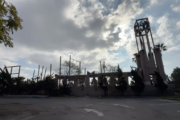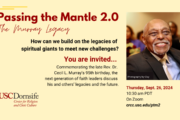This article was originally published in The Juggernaut, with the support of CRCC’s global project on engaged spirituality.
When restaurant owner Ruhel Islam said “let my building burn” last month in Minneapolis, he instantly captured a pulsating national mood. He also seemed to throw a glass of ice-cold water on the South Asian American community, who, in broad strokes, have long been complacent about showing up for and protesting alongside Black Americans against police brutality and for civil rights.
Islam’s face became well-known through a now-viral Facebook post, and in the New York Times, where the Bangladeshi American spoke about how his beloved downtown restaurant, Gandhi Mahal, was burned to the ground by protesters. But Islam wasn’t mad, stating that it could be rebuilt and that the protesters’ anguish was justified. The radical commitment of his actions cut through the miasma of posts and occasionally pointed silences, the screen-based modes of quarantine-era solidarity. Here was a South Asian American who was really walking the walk. Not only did he support the protesters, but he even gave up what was left of his restaurant to medics for them to use in the following days and cooked up vats of dal to feed them.
I thought of Islam alongside Rahul Dubey, the Washington, D.C. dad who sheltered more than 70 protesters in his house in early June, and the online satsangs of the progressive American Hindu organization Sadhana that posit dismantling anti-Blackness as a spiritual pursuit. From coast to coast, South Asian Americans I spoke to agreed: This time feels different. These new kinds of South Asian allyship with Black Lives Matter are more vocal, forceful and humble than previous iterations. They are marked by a willingness to put bodies on the line and use more relatively privileged identities to amplify Black Americans’ fight.
As Haaris Pasha, a Pakistani American activist and attorney in Minneapolis told me: “I think this shook folks in a different way.”
I went to meet Islam and his daughter, Hafsa, at the site of Gandhi Mahal, in Minneapolis’s Longfellow neighborhood, not far from the Third Precinct police headquarters, which was also burned to the ground. The restaurant was in ruins, with piles of cinderblocks, metal pipes and rubble reaching nearly a story deep into the ground. Islam and his brother opened the restaurant in 2008 and named it after Mahatma Gandhi, whom their activist grandfather met in their hometown of Moulvibazar, Bangladesh, during the independence struggle against the British Raj.
“My dream is to rebuild this even better than before, spilling out into the street, and with chickens and goats running around,” said Islam, wearing a white face mask and sunglasses. “We grew up in a food culture,” he said, of his home in Sylhet, a lush province in northeast Bangladesh known for its entrepreneurial diaspora. Islam came to New York in April 1996, married a Bangladeshi American (who was raised in the city’s East Village) in 2000, and moved to Minneapolis in 2005.
“When I took the U.S. citizenship oath, they told me to bring your culture with you. And I did. Bangladesh is the country of rivers and lakes, and Minneapolis is the city of lakes. We love fishing back home, and I have even learned ice fishing here — I’m a proud Minnesotan.”
“It was actually very tense when we started the restaurant,” he recalled, “right after the financial crisis, when people didn’t trust each other.” He said it was a time of a lot of Islamophobia, when the Minneapolis community was wary of forming new connections after the devastating economic downturn. Islam immediately tried to change that, opening up part of his restaurant as a community space for activists and organizers, inviting patrons to bring mats during Ramadan to have outdoor, fast-breaking “iftar block parties” on the pavement, and partnering with local university students to bring sustainable farming on-site.
“When we first started, we had to import frozen curry paste, but now we grow our own curry leaves here,” he said, proudly. He didn’t realize it at the time, he said, but Sylhet had its own “closed-loop,” hyperlocal food system, which he took pains to recreate in the Twin Cities. He harvested fresh produce from a collection of backyard gardens, and audaciously set up an aquaponic garden in the basement of the restaurant, where dozens of tilapia fish swam in tanks and their waste fertilized vegetables growing in water under artificial light.
“Well,” he said cheerfully, “at least our tilapia have survived.” The kitchen will have to be rebuilt. Due in part to his viral fame, a crowdfunding campaign to help offset the costs raised $118,168 in two weeks — surpassing the initial goal of $100,000. There will also be some compensation from insurance, although most acts of looting are not covered, said Islam.
Islam was the fourth of seven children in Sylhet. One of his uncles was Saifur Rahman, a renowned economist who served three separate terms as the country’s finance minister. Though Islam rarely finds time to get away in long stretches from the restaurant, he once brought a group of 21 university students and professors from Minnesota to his hometown to show them its agricultural traditions.
Hafsa, the oldest of Islam’s four children, has been his indispensable deputy since she was 14. She is now 19 and just finished her freshman year of college, where she’s studying mechanical engineering.
Given how deeply embedded the family is in this neighborhood, they are no stranger to its policemen. “We knew Derek Chauvin [the cop who killed George Floyd] and Tou Thao,” the now-infamous Hmong American cop who was a bystander to the killing, said Hafsa. In a bizarre coincidence, Hafsa actually saw Floyd get arrested at the Cup Foods deli the day he was murdered — and she posted it to her Snapchat, writing, “I bet they only arrested him because he’s Black.” Hafsa has noticed more police are generally stationed in more densely populated and racially diverse Minneapolis neighborhoods like Longfellow.
So it was a no-brainer for their family to support the protests that erupted there soon afterward.
There isn’t a huge Bangladeshi diaspora community near them, said Islam. “Maybe two or three families. But that’s not really what we mean by community, is it? This,” he gestured around the block, where nearly every business is still boarded up, “is our community. Community isn’t just one culture.” Minneapolis is about 64% white today; in 1950, it was 99%, meaning it became rapidly more diverse in a short timeframe, due to several factors, including “white flight” to the suburbs and the arrival of immigrants and refugees, like the Hmong from Laos starting in 1975. About 6% of the city, home to more than 416,000 people, is Asian.
The Islams have supported Black Lives Matter since it started in 2013, and Islam even participated in Occupy Minneapolis back in 2011. “We fed dal bhat and saag to everyone then too,” he said. “Gandhi Mahal has always been more than a restaurant.”
All across the Twin Cities, South Asians are discovering that there are “many ways to show up” for the Black community, said Haaris Pasha, the attorney and activist.
“I know there’s a lot of callousness in our communities, and colorism, but at least nominally, people are now understanding that specific injustice toward Black people is a real problem,” he told The Juggernaut.
Pasha’s father came to Minneapolis in 1973, and Pasha said he had a typical suburban upbringing, with “no real exposure to urban poverty.” Pasha’s own activism started after Michael Brown was killed in Ferguson in 2014 — but no incident has had as much impact in the Pakistani American community, and with such speed, as the killing of George Floyd. “A lot of the desi community knew Philando Castile, because he worked in [public] schools,” he said, referring to the 32-year-old Black man who was killed by police in Northeast Minneapolis in 2016, sparking nationwide protests. “But they didn’t come out so much. This time was so different. Even my mom, for instance, compared Floyd’s killing to that of the torture endured by the early Muslim Bilal [who was born a black, half-Abyssinian slave], trying to make her own connections.”
Pasha’s mosque in north Minneapolis, Masjid An-Nur, quickly organized the collection and distribution of thousands of masks per day to protesters, he said. “Maybe they’re not all going to show up at the protest, but they find ways to show up behind the scenes, too.”
“We live in a very white state, and the suburbs are extremely white,” said Pasha. Against that backdrop, Twin Cities mosques act as effective “intermediary” spaces for South Asians and many other people of color to figure out how to interface with the community at large. “Our mosque has Somalis, Black Americans, Palestinians, etc., so we…interact with a whole plethora of people who don’t look like us,” beyond specific diaspora communities.
South Asian Americans beyond the Twin Cities also felt the Floyd protests have been a major turning point.
For Pahini Pandya Lampart, an Indian American who moved from Gujarat to Pennsylvania when she was nine, allyship is not a choice: She is the mother of a 3-year-old Black son and has been married to a Black man since 2016. Yet, she told me, she rarely spoke publicly about Black Lives Matter until this year.
“These protests are when it started hitting home for me,” she said, speaking to me from her home in Baltimore. “Before, I felt like an ally, but from a distance. I wasn’t really vocal about my fears with my family or the Hindu community until Sadhana reached out to me.”
Sadhana is a nationwide “coalition of progressive Hindus,” a movement that has carved out a space in American religious life for Hinduism explicitly geared toward intersectional activism and social justice. It started in Brooklyn and now counts about 100 active members and a few thousand more casual followers. Sadhana member Hari Venkatachalam, who had gone to college with Lampart, saw a Facebook post she wrote after the Floyd murder and invited her to speak on their next satsang, or “gathering” — the weekly cornerpiece of the Sadhana community, which are temporarily on Zoom.
Two recent Sadhana satsangs have explicitly focused on Black Lives Matter. “As Hindus, we are called to embody para-dukha-dukhi: feeling the pain of others as our own,” Venkatachalam wrote for the satsang introduction on June 4, about a week into the protests. “In…the U.S., it is Black communities who have been facing particularly brutal violence at the hands of law enforcement for decades.”
I tuned in on Zoom and was struck by the difference in tone from any Hindu American space I had encountered in the East Coast Hindu temples of my youth, where Brahmin priests usually conduct prayers in Sanskrit and donations often go toward physical renovations and importing costly idols. Three dozen attendees were watching from across the country, including Florida, Illinois, Maryland, New York, California, Arizona, Colorado and Massachusetts.
“May we take this opportunity to rid our communities of anti-Blackness,” said Venkatachalam. He invoked the Hindu values of nyaya (justice) and prema (love), and said the weekly meeting would be dedicated to asking “how we as Hindu Americans can show up as better allies for our Black brothers and sisters.”
Sadhana’s pandita, or female priest, Pratima Doobay, sang a Sanskrit hymn in front of a portrait of the goddess Kali and explained her rituals at every step in English. “I want to say the name of George Floyd, Ahmaud Arbery and Breonna Taylor,” she said, “and ask the Divine to hold them close and offer them healing.” Doobay said she was doing a “manas puja,” an offering for God through the mind and the heart, which took about 10 minutes.
Then she ceded the floor to two Black Christian pastors based in New York, Reverend Dr. Gwendolyn Hadley-Hall and Reverend Dr. Damaris D. Whittaker. Neither of them spoke to Hinduism, per se, but assumed the audience could make their own connections.
“According to the God I serve, he’s tired,” said Hadley-Hall, a veteran activist who has marched since the 1970s. “I need you, you need me.”
Whittaker demanded more of the attendees. “I am asking you to use your privilege,” she said. “You need to put your bodies on the line…I cannot in good conscience tell my [Black] constituents to go out there.” It was a clarion call to action.
Activist Sunita Viswanath founded Sadhana in 2011 after she believed there was no real way to be a Hindu in the U.S. that was explicitly aligned with her social justice commitments to anti-casteism and anti-racism.
In the early years of Sadhana, Viswanath also held classes for Hindu American kids in her community — including her youngest son — that addressed Black Lives Matter. After Eric Garner was killed in a chokehold by the New York Police Department in 2014, “[the kids came] with their questions about Black Lives Matter, and how is this possible,” Viswanath recalled. They organized a small protest: “We just walked around the block. The kids chanted, ‘Om shanti om. Black lives matter. Om shanti om.’”
Sadhana probably lost some followers as it stuck to its social justice mission, said Viswanath. “But we wouldn’t want to have a Sadhana that doesn’t participate in Black Lives Matter.”
President Lyndon Johnson signed the Immigration and Nationality Act of 1965 that opened the floodgates to South Asian immigration and citizenship (about 6.3 million South Asians are in the country today) under tremendous public pressure at the height of the Civil Rights Movement. The long tradition of solidarity between Black Americans and South Asian social justice movements dates back to the 19th century — including between Black and Dalit activists.
“I firmly believe that if we knew our histories, we would realize how best we can show up as allies and co-conspirators in this moment,” said Anirvan Chatterjee, an Indian American historian who lives in Berkeley and runs Black Desi Secret History.
The importance of individual stories, from Islam today to Swami Vivekananda in 1900 — who once condemned anti-Blackness in Pasadena, California — is that they “show what it looks like to be an ally,” said Chatterjee. Allyship will naturally mean something different in every particular moment, but it doesn’t have to be terra incognita. “Knowing how someone who looks like you fits in is important,” he said.
Before I left Islam’s restaurant earlier this month, he insisted on showing me the “interfaith garden” he had helped plant, along with an indigenous peoples’ ministry, in a backyard in the Corcoran neighborhood, a few minutes’ drive away. In neat rows, he was growing flat “Bangla beans,” garlic scapes, kale, tomatoes, silvery sage and other crops.
“Of course our struggles are connected,” he said. “Here, it’s racism; where I grew up, it was colorism and casteism.” One thing he never takes for granted is the right to protest, he said. “In Bangladesh, not only can’t you protest, but they will disappear you, and even harass your family members. That’s why we can’t waste the opportunity to participate here.”
He thinks it may take two or three years to rebuild his restaurant. But he is nothing if not patient. “I was dark-skinned growing up and everyone called me kala, black, and said I would never get married,” he said. “But my mother said not to worry, sabar [patience]: One day the whole world will know you.”
Read the article on thejuggernaut.com.
Krithika Varagur is a journalist fellow with the Spiritual Exemplars Project.







